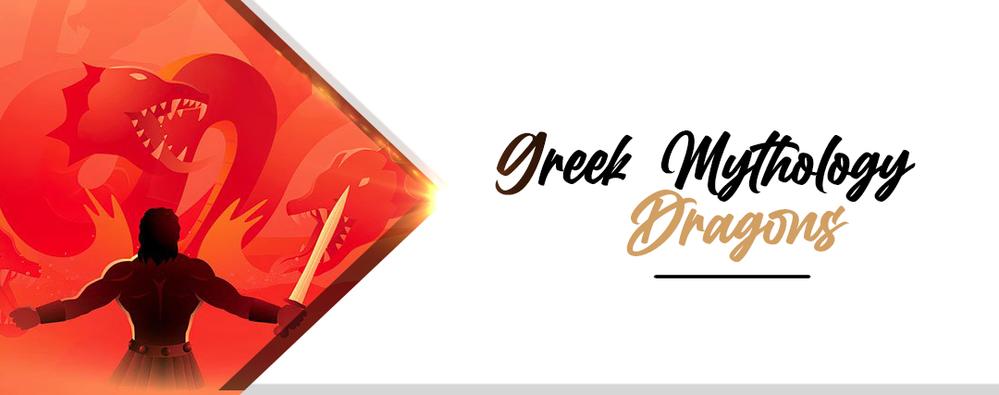
The dragons of Greek mythology are different from the winged creatures depicted in the folk tales and legends we are used to knowing. They were more like serpentine monsters, the majority of which do not have the ability to fly like classical dragons. The Greeks split dragons into three categories of family:
- The Dracones: giant snakes, usually possessing deadly venom and many heads.
- The Cetea: sea monsters that often appear in myths where the hero saves a princess.
- The Dracaena: these creatures display the characteristics of a woman and a snake, or a female dragon.
The heroes are probably part of the best-known part of Greek mythology, but what makes a hero? In the mythological sense, a legendary hero is distinguished by his actions and exploits. One must fight and defeat monsters at great risk to make a mark.
By chance (or misfortune), the myths of Ancient Greece abound with creatures and monsters each more bizarre than the last. Both fantastic and terrifying, these mythical beings are very numerous. Ranging from Dragons, Giants, Demons and Ghosts, to hybrid creatures like the Sphinx, Minotaur, Centaurs, Manticores and Chimera. ????
In this article, we’re going to look at dragons in Greek mythology. Their stories, their appearances, their relationship to the gods, and their purposes. You’ll learn some remarkable facts and tidbits about these many mythical monsters of Ancient Greece.
The Dragon Typhon
In Greek mythology, Typhon was considered to be the most powerful and deadly evil deity. He was the last offspring of the Goddess Gaia and the God Tartarus. He was conceived to prevent the Olympian gods from defeating the Titans during the Titanomachia. According to some myths (Homeric Hymns), he is an evil being birthed by Hera for the sole purpose of defeating Zeus.
Known by the epithet of “father of all monsters“, Typhon was a fire-breathing being whose name alone was enough to arouse fear and awe. In Greek legends, be aware that his physical description of the dragon Typhon differs from story to story.

Typhon was a colossal winged beast whose head and body were that of a man. He was a giant so huge that he grazed the stars. Typhon had a hundred dragon heads sprouting from his shoulders, he also had snake heads on his fingertips. From the waist down, a hundred venomous snakes formed the mass of his body. Typhon’s ears were pointed, and his hair and beard were matted and dirty.
From the eyes, mouth, and nostrils of each of his heads sprang flames. Each mouth had its own horrible voice and its eyes never closed. Typhoon’s form was nebulous in nature. In summary, most descriptions attribute Typhon with a giant size, the tail of a snake, multiple dragon or serpent heads, dark tongues, eyes of fire, and a thunderous voice.

Gaia was furious at Zeus for imprisoning her children, the Titans, in Tartarus. She rallied her other children, the Giants, to avenge the injustice, but they too were defeated. As a result, she created Typhon as the ultimate adversary of Zeus. For this reason, Typhon is sometimes classified as a giant. In one version of the story, Typhon is said to have defeated the supreme god one-on-one.
When the gods of the Cantheon saw Typhon approaching, they fled in terror. One tradition has it that they ran to Egypt, where they were transformed into animal figurines that symbolize Egyptian deities, or that they transformed themselves into animals. Athena, the goddess of wisdom, persuaded them to return to Greece, while Zeus stayed behind to confront the dragon Typhon. ⚡
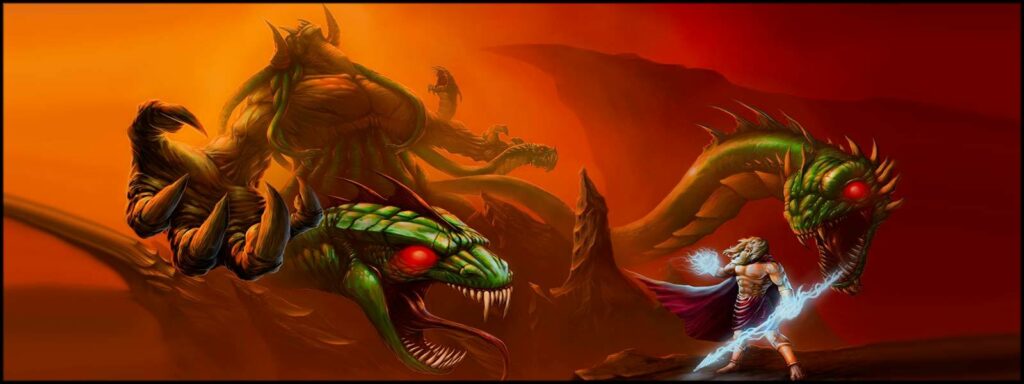
Typhon, the living nightmare of the Olympian gods, never slept. He wanted to acquire the sovereignty of the gods and mortals, but was subdued by Zeus’ lightning after a frightening struggle. Zeus locked him under Etna, a volcano where the forges of the god Hephaestus are located.
If Typhon seized Olympus, the home of the gods, he would have become the master of the world, and Zeus could not allow this. Typhon was married to Echidna, who was considered the “mother of all monsters.” They both had many famous offspring, including:
- The Sphinx
- The Lion of Nemea
- The Cerberus
The Hydra of Lerna
In Greek mythology, the Hydra of Lerna was a gigantic nine-headed water snake, which haunted the Lernaean marshes. It was one of the twelve labors of Heracles. Sent to defeat the creature, for every head he beheaded, two more grew. He enlisted the help of his nephew, Iolaos, who applied flaming firebrands to the severed heads, cauterizing the wounds and preventing the regeneration of the Lernaean Hydra.
Hera, who had bred the monster specifically to kill Heracles, sent a giant crab to the Hydra’s rescue. During the battle, Heracles crushed the crab under his foot. The Hydra and the Crab were later placed among the stars by Hera as the Constellation of Hydra and Constellation of Cancer.

The Hydra of Lerna was the offspring of Typhon and Echidna. This mythical creature was sometimes considered the demon of darkness and drought. The Lernaean Hydra lived in the swamps and marshes of Lerna in Argolide. It ravaged the local province of Argos.
The Hydra was sacred to Hera, but the dragon so tormented the people of Argolid that the king Eurystheus ordered Heracles to kill it. The Hydra of Lerna left its home only to consume livestock or destroy crops. Its breath reeked of venom, and its fetid exhalations poisoned the air.

The last head of the Hydra of Lerna, the middle one, was immortal, but Heracles managed to destroy it using the golden sword that the goddess Athena had given him. Heracles placed the head, still alive and writhing, under a large rock on the sacred path between Lerna and Eleonius. Then he dipped all the tips of his arrows in the venomous blood of the Hydra.
This action would later mark the end of the hero, for Heracles would wear the Tunic of Nessus on which the centaur’s blood had mingled with the blood of The Hydra of Lerna. This will cause him unbearable pain, and he will end up incinerated on the Mount Oeta.
The Dragon of Thebes
In Greek mythology, the Dragon of Thebes also named the Ismenian Dragon was a giant snake that guarded the sacred spring of Ares near the city of Thebes. According to Theban legend, the hero Cadmos, after triumphing over the dragon, became the founder and first king of Thebes.
On the instructions of the oracle of Delphi, Cadmos followed a special cow which he sacrificed for Athena or Zeus. The place of the animal’s sacrifice marked the birth of the city of Thebes and its acropolis, Cadmos. To accomplish this, he sent some companions to draw water.
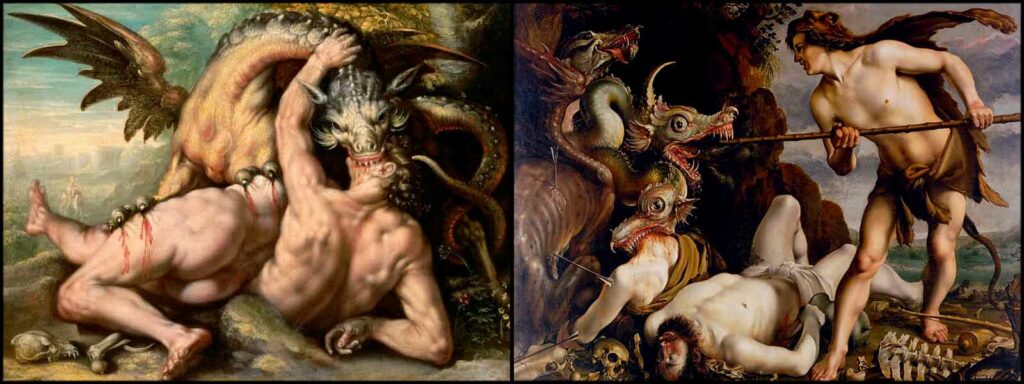
Unfortunately, the source of water was guarded by a dragon, one of the sons of Ares, who killed his men. The dragon of Thebes was in turn killed by Cadmus. The latter was ordered by Athena to sow the dragon’s teeth into the earth, from which sprang armed warriors, called the Spartans. Cadmos, terrorized, threw a stone at them. The latter thinking they were attacked, killed each other and only five survived:
- Echion
- Oudaios
- Chthonios
- Hyperenor
- Peloros
Thereafter, these five Spartans helped Cadmos build the Greek city of Thebes and the Theban Acropolis. They became the founders, and then the ancestors of the noblest families in the city of Thebes. The dragon was sacred in the eyes of Ares, so the god imposed on Cadmus to do penance for eight years serving him. After that, Athena assigned him the government of Thebes, and Zeus offered him Harmony, his daughter, as a wife.
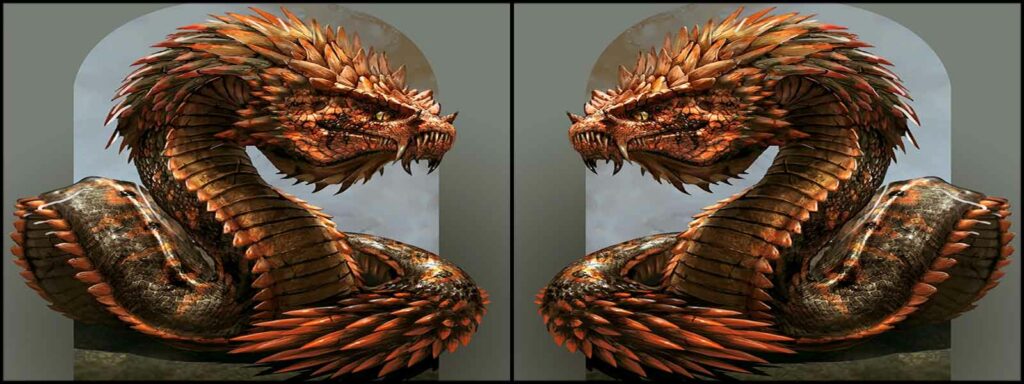
The Dragon of Colchis
In Greek mythology, the Dragon of Colchis, the offspring of Typhon and Echidna (or Gaia), was the keeper of the Golden Fleece in the sacred grove of Ares. Jason, a Greek hero, claimed from his uncle Pelias, son of Poseidon, the throne of his father Eson, former king of Iolcos who was dispossessed by the latter. Pelias promised to return it to him on condition that he bring back the famous Golden Fleece, which is found in Colchis.
So Jason embarks on the Argo, a galley, with the Argonauts in search of the coat. Once they arrive, Jason claims the golden fleece from Aeetes, the king of Colchis. Aeetes in turn promised to give it to him only if he could accomplish certain tasks. First, Jason was to plow a field with fire-breathing oxen that he had to harness himself.
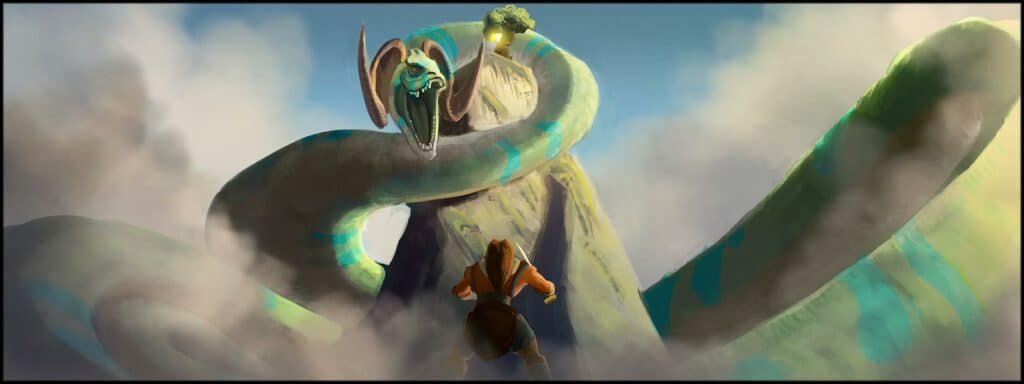
Then Jason was to sow the teeth of a dragon in that same field which was the sacred domain of Ares. The teeth sprouted and an army of warriors emerged from the earth. Jason thought and before they could attack him, he threw a stone into the crowd. Unable to determine where the projectile had come from, the soldiers clashed and killed each other. This story is quite similar to the one in Cadmos and the Dragon.
Finally, Aeetes forced Jason to fight and kill the Colchis dragon, an insomniac creature that guarded the golden fleece. Jason succeeded in defeating the beast, retrieved the fleece, and embarked with Medea, a sorceress/magician, daughter of Aeetes. She had helped Jason in his quest and had fallen madly in love with him. Another version says that Jason was swallowed and then spit out before defeating the Colchis dragon.

The Ladon Dragon
In Greek mythology, the Ladon Dragon, also known as the Dragon of the Hesperides, was the guardian of the golden apples in the Garden of the Hesperides. This massive hundred-headed dragon was one of the monstrous offspring of Typhon and Echidna. Ladon is related to the eleventh of the twelve labors of Heracles. Having already defeated many monsters, Heracles took his bow and simply killed the dragon with a poisoned arrow.

This Ancient Greek dragon with a hundred heads and a hundred voices, had a penchant for gold. The goddess Hera tired of seeing the Pleiades, daughters of the Titan Atlas, coming to the garden and stealing golden apples, persuaded the dragon Ladon to watch over the apple tree.
From then on, Ladon wrapped himself around the tree and began to watch all directions at once. When one of his heads was asleep, the others were awake, so that it was impossible to surprise the Hesperides dragon. Because of Hera’s resentful nature, Ladon also had the secondary task of torment to the Titan Atlas, who stood nearby, holding the sky on his shoulders.

Ladon met his fate when Heracles was tasked with bringing back golden apples from the garden. The beast was slain with the bow and arrows possessed by the Greek hero. The dragon remained in the throes of death for a long time, and the Hesperides mourned the loss of their protector. This drew Jason and the Argonauts to the garden the very next day, where they witnessed the last moments of the Hesperides Dragon.
Zeus admired the battle so much that he raised Ladon in the night sky as the Constellation of the Dragon (Draco). Another legend says that it was Hera who placed his portrait among the stars for the dragon’s dedication to her garden, and his efforts to kill Heracles.

The Cychreides Dragon
The Cychreides Dragon was a giant snake that terrorized the island of Salamis, a Greek island located in Attica. According to some, it was killed by Cychrea who became king as a result of this feat. According to others, Cychrea would have raised the beast which would have been chased from the island by the hero Eurylochus, a companion of Odysseus. The dragon is then said to have swum across the sea to Eleusis where it became the pet of the goddess Demeter.
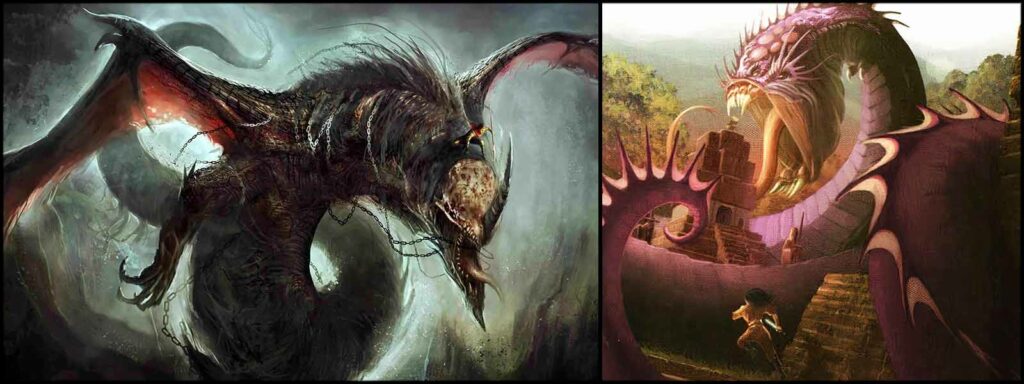
According to another account, Cychreides himself was called a dragon because of his wild nature. Banished from Salamis by Eurylochus, he was received by Demeter at Eleusis in order to be appointed a priest in her temple. The legend is that during the battle of Salamis, a dragon appeared on one of the Athenian ships and an oracle declared that this dragon was Cychrea. ????
The Python Dragon
In Greek mythology, Python was a monstrous snake dragon charged by his mother Gaia, the earth goddess, to protect the oracle of Delphi. According to some accounts, the creature was born from the decaying slime left by Deucalion’s Flood.
According to Greek legend, Zeus laid and impregnated the goddess Leto of twin gods, Artemis and Apollo. The Dragon Python is said to have been sent by Hera to chase away Leto in order to prevent her from giving birth, as the latter was jealous and enraged over Zeus’ infidelity.
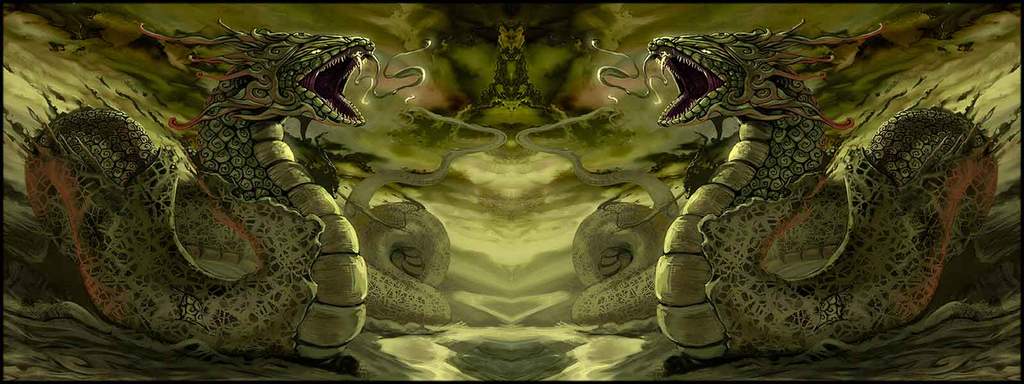
Apollo wanting to avenge his mother for being pursued by the dragon relentlessly during her pregnancy, armed himself with a bow and arrow made in a forge from the god Hephaestus. He in turn chased the dragon to his cave, Mount Parnassus, there followed a legendary fight between the god and the monster.
Python was not an easy opponent for Apollo to defeat, but firing a hundred arrows, Python eventually succumbed to his wounds. Thereafter, Apollo claimed the oracle of Delphi which was renamed “Pythia.”

Sources tell us that Apollo had to engage in an eight-year period of servitude after the murder of Gaia’s child, and that he would have established the Pythian Games as an act of penance. The god could also have decreed these Delphic Games as a celebration of his victory over Python. The Homeric hymn to Apollo and some ancient Greek art equate Python with Echidna.
Andromeda and the Sea Monster
In Greek mythology, Andromeda is an Ethiopian princess, daughter of King Cepheus and Queen Cassiopeia. Her mother boasted that she and her daughter were the most beautiful to the Nereids, the nymphs and daughters of the old sea god Nereus. The latter went to complain to Poseidon, which provoked the wrath of the God of the Sea, on the kingdom of Ethiopia.
The punishment took the form of a great tsunami that destroyed much property and farmland. Poseidon also sent Ceto, a sea monster that swept the unwary ashore. Desperate, King Cephaeus consulted the oracle of Amon, who told him that no respite could be found until he had sacrificed his daughter to the sea monster. Andromeda was chained to a rock awaiting her death.

However, luckily, the hero Perseus was nearby, he prevented Andromeda’s imminent death. When the monster emerged from the sea, he managed to kill it, either with his sword or by exposing it to the head of Medusa and turning it into stone.
Thus, Andromeda was saved from the sea monster. Perseus married her and she followed him on his journey back to Greece. They had nine children together. After his death, the goddess Athena placed her in the sky as the Constellation of Andromeda, near her beloved husband Perseus and his mother Cassiopeia.
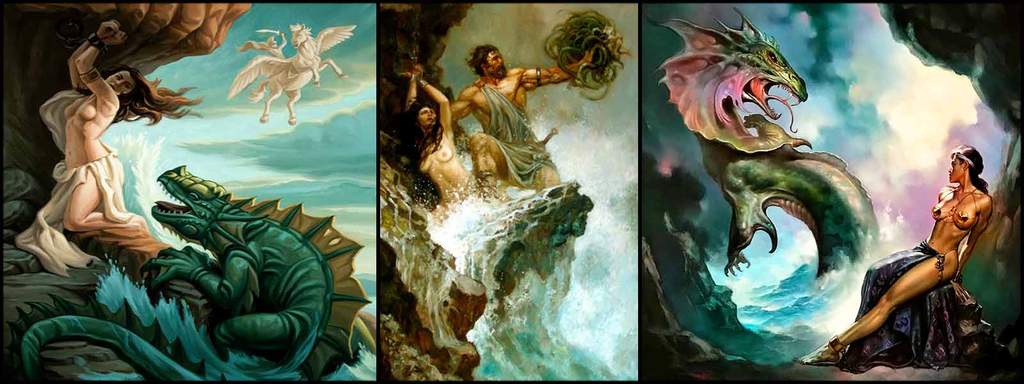
Hesione and the Dragon
In Greek mythology, Hesione is a princess, she is the daughter of the Trojan king, Laomedon and the nymph Strymo. She is also the granddaughter of Ilus, the mythical founder of Troy. She was to be sacrificed to the ceto, a sea monster sent by Poseidon, who devastated the land until Heracles freed her from her chains. This legend is very similar to that of Andromeda and the sea monster.
The main myth of Hesion and the dragon tells that the gods Apollo and Poseidon were angry with King Laomedon. The latter, not having recognized the deities, had not paid them as promised their dues, after they had built the walls of Troy. In retaliation, Apollo sent the plague on Troy, while Poseidon sent a sea monster, nicknamed the Troy Ceto, to terrorize the shores.

To appease the sea monster, the Trojans were forced to sacrifice a young girl, abandoning her chained to a rock on the shore. The sacrifices being drawn by lot, it was the name of Hesione that was designated to be the next victim of the Trojan sea monster.
Heracles returning from the land of the Amazons, promised that he would save Hesione and kill the sea monster on condition that Laomedon give the divine horses. Zeus had given them to Laomedon as compensation for the kidnapping of Ganymede. Laomedon readily accepted the deal.
So, Heracles killed the sea monster and broke the chains of Hesione, then returned her to Laomedon. But once again, the Trojan king refused to pay for the services rendered. Heracles had no time to deal with the king at this time, but the Greek hero vowed to return.
The Dragons of Medea
In Greek mythology, Medea was the daughter of Aeetes, king of Colchis, and the wife of the mythical hero Jason. According to legend, the witch Medea had a chariot, the Char of Medea, which was harnessed by dragons. Medea’s dragons were two dragons that pulled the witch’s flying chariot. She summoned them to take her away from Corinth following the murder of King Creon, his daughter Creuse, and her children whom she had with Jason.

Echidna: The Mother of All Monsters
In Greek mythology, Echidna is a half-woman, half-snake creature. She is the daughter of Gaia and Tartarus, as well as the wife of Typhon. Echidna is nicknamed “mother of all monsters”, as she gave birth to most of the mythical creatures of Ancient Greece.
The famous couple attacked the Olympian Divinities, but Zeus managed to repel them, burying Typhon under Etna. Echidna and her children were spared to continue challenging the future heroes. Echidna was later killed by the Giant Argos Panoptes while she slept.
According to the poems of Hesiod, Echidna was immortal, he believed that the “mother of monsters” continued to live in her cave, sometimes devouring the unwary who passed through her entrance.

Echidna and Typhon have found a home on earth, the pair residing in a subterranean in Cilicia, in the land of the Arimes. They will give birth to a series of monstrous descendants. Among the most famous children of Echidna and Typhon are:
- Cerberus: the three-headed dog that guards the gates of the Underworld and the kingdom of Hades.
- The Hydra of Lerna: the dragon-serpent with multiple heads that grows back.
- The Gorgon Sisters: Euryale, Stheno and the most famous of which is Medusa.
- The Chimera: a creature that is half lion and half goat, with a snake or dragon tail.
Echidna via Orthos (two-headed dog) and the Chimera, is said to be the grandmother of the famous Sphinx and the terrible Lion of Nemea.

Greek stories describe Echidna as half nymph and half serpent in appearance. Her upper body, from the waist down, was feminine, while the lower half consisted of a single or double snake tail. In addition to her monstrous appearance, Echidna also had other monstrous characteristics, it was said that she had developed a taste for raw human flesh. ????
The Camped Monster
In Greek mythology, Camped is one of the famous monstrous creatures nicknamed “dracaena” (Greek drakaira), a female dragon or snake woman. She appears in relatively few ancient texts, this is due to her connection with the Titanomachia, the war between the Titans that lasted ten great divine years (i.e., several human centuries). A story from Greek mythology where no source has survived.
Campé is generally considered to have been the child of the primordial deities, Tartarus, the pit of hell, and Gaia, the Earth. Nonnos of Panopolis, a Greek poet, would call Campé the Nymph of Tartarus. Thus, it was with the underworld of Greek mythology that the dracaena was primarily associated. She was responsible for keeping the Hecatonchires and Cyclops locked up in Tartarus.

However, when the Olympian Gods began their battle with the Titans, Zeus descended to the underworld to kill the monster Camped in order to free the prisoners of Tartarus. These helped him win the battle against Chronos, the god of space-time and destiny.
For physical description, Kampé had the head and upper body of a beautiful woman, the lower body of a dragon or snake, and the poisonous tail of a scorpion. She also had snakes wrapped around her ankles and the heads of various beasts at her waist. ????????
The Dragon Chimera
In Greek mythology, the Chimera is a hybrid monster, child of Typhon and Echidna. He is the brother of Cerberus and the Hydra of Lerna. This fantastic creature was evil, its body was that of a lion and a goat. She had a lion’s head, as well as a goat’s head on her back and her tail was shaped like a serpent or dragon.
Famous and fearsome, the Chimera was a female, and according to Hesiod’s genealogy of Greek deities (Theogony), the Chimera would mate with Orthos to give birth to two other monsters, the Nemean Lion and the Sphinx.

He resided in Lycia, a place in Asia Minor, where he ravaged the land with his fire breath. He was killed by Belerephon, assisted by Pegasus, when the latter was requested by King Iobates of Lycia. Belerephon rode on the back of Pegasus, a horse that could fly, and shot arrows at the Chimera from the air.
This list about dragons in Greek mythology is coming to an end. You will have learned a little more about the famous creatures, deities and monsters of Ancient Greece. If you want to go even further, you can tame the beast by taking on the dragon chimera. ????
